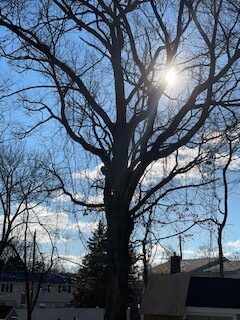-

Plymouth, Massachusetts gets an average of 51 inches of rainfall every year; this is 13 inches more than the national average and with that much rain and so many trees, especially around the residential areas, it is not uncommon to see trees topple over after a heavy rainfall.
Rainfall is usually good for trees as it helps them stay hydrated especially when the soil is dry, too much of rain can, however, smother the roots, causing the tree to weaken, die or fall over. Here is how some effects of rainfall may affect trees in your area to the point where you may need tree removal.
LOWERED TEMPERATURE
The temperature has an impact on all plant’s processes, including photosynthesis and seed germination. Warm temperatures generally aid in early maturity of fruits and seed but extremely hot weather will increase the maturity period. Excessive rainfall causes a drop in the temperature and while some fruit trees such as peaches and cherries require low temperatures to grow, other trees may become dormant during long periods of low temperature to withstand the cold. This will have a detrimental effect on the growth of such trees.
HIGHER PRECIPITATION
Precipitation means the amount of water falling out of the sky in form of rain, snow or drizzle and it is especially higher during long periods of heavy rainfall. Trees generally require water to stay alive and healthy and to complete almost all their processes such as photosynthesis, the process by which plants manufacture food. Without water, trees become unable to manufacture their food, thus, they suffer from nutrient deprivation which may lead to the death of the tree. In this case contacting a tree service near you to discuss tree removal of the dead tree may be in order.
On the other hand, extreme rainfall over a long period may lead to erosion, causing the soil to lose Nitrogen, another important element in photosynthesis. It may also cause the soil to get compacted. Roots need aerated soils in order to access oxygen on the soil, thus a compacted soil will hinder the root from reaching oxygen in the soil.
INCREASED WIND
Heavy downpour is usually accompanied by heavy wind. Winds are necessary for pollination of seeds with can help in growth but a heavy wind can cause the spread in pathogens and insects which could damage some trees. Also, Heavy winds accompanied by heavy rain could cause trees to fall over.
INCREASED HUMIDITY
Humidity is the amount of water vapour in the atmosphere; humidity is generally higher during the rainy season. Humidity is very important in transpiration; a process by which plants “breathes”, losing excess water in form of vapour. When the water vapour in the air is high, plants become unable to lose this water vapour, this causes the plant to be unable to draw nutrient from the soil (a part of the transpiration process) and when this happens for a long time, the plant will eventually rot.
REDUCED SUNLIGHT
The importance of sunlight to the growth of trees cannot be overemphasized. Sunlight is needed for all important processes in plants thus, rainclouds, which accompanies heavy rainfall, reduces the availability of sunlight to trees, limiting the growth, reproduction and photosynthesis.
Generally, there is no universal definition for “heavy rainfall” as it depends on the usual rainfall in a particular area. Also, one heavy rain will not have a negative effect on a tree as trees will quickly recover on their own, however, heavy rainfall over a long period will require some effort and help from property owners in order for the trees to recover.
After a period of heavy rainfalls, many property owners begin to wonder how they can help their trees recover from its impacts. Some of the things to do to assist trees to recover include the following.
CONTACT AN ARBORIST
After a series of rain and wind storms, it is important to call for a professional to take a look at the trees. An arborist will carry out a risk assessment of the tree to determine if an emergency tree removal or tree trimming needs to be done or if the tree can be saved.
It is also important to contact an arborist before planting a tree at all as the arborist will be able to tell which trees will be best for the climatic conditions of the areas, this will ensure that the trees that will be planted will be able to withstand the weather conditions of the area, thus preventing tree damage due to rainfall, winds, humidity and so on.
FERTILIZERS AND WATER
After heavy rainfall, it is important to allow the tree to recover before applying fertilizers or water. Before you proceed to water the tree, dig the ground beside it; do not water the trees if there is still water lodged in the soil. Better still, reach out to a professional arborist before applying anything to a tree after heavy rainfall.
PLANT LOCAL TREES
Local trees have been in an area for extended periods and thus can withstand the climatic conditions of the place. It is best to plant trees like this in an area to ensure that they would be able to survive the conditions of the place.
AERATE THE ROOTS
After heavy rainfall, the soil becomes compacted; this can cause roots to shrivel out of the ground in search of oxygen, which could lead to the weakening of the roots and falling over of the tree. To avoid this, you will need to aerate the trees; this can be done manually with the use of a shovel to turn around each tree. This procedure is however dangerous as a novice can easily injure the roots of the trees, thus, an arborist should be called as they can get professionals to do the aeration.
Lastly, it is important to know when to say goodbye. Removing a tree can sometimes be emotional, especially when the tree has lasted a long time; however, if heavy rain has destroyed the tree beyond repair, an emergency tree removal service must be called. This is to avoid the sudden collapse of the tree which can cause injuries, death and destroy properties.
CAN TOO MUCH RAIN AFFECT MY TREES?
Are Trees Damaging Your Property?
Sometimes one bad tree can damage your entire landscape and even your home. Consult with our trained staff for a free assessment
Available 24/7 for Emergency Service
Did lightning strike? That’s our specialty. One call and we will dispatch our emergency response team to handle all your emergency tree service needs
Hours
Monday: 7:30am - 6:30pm
Tuesday: 7:30am - 6:30pm
Wednesday: 7:30am - 6:30pm
Thursday: 7:30am - 6:30pm
Friday: 7:30am - 6:30pm
Saturday: 7:30am - 6:30pm
Sunday: Closed
We Are Serving Plymouth, MA | Milton, MA | Canton, MA
Copyright © 2022 - Lighting Strikes Tree LLC. All Rights Reserved.
